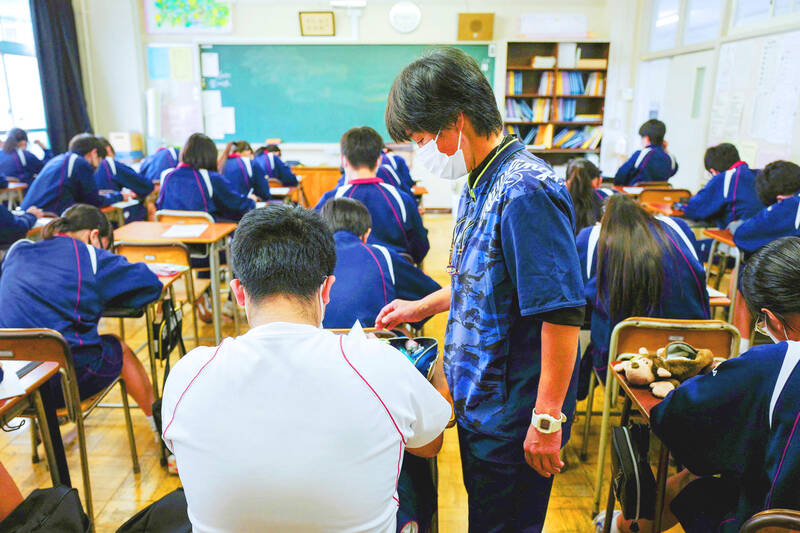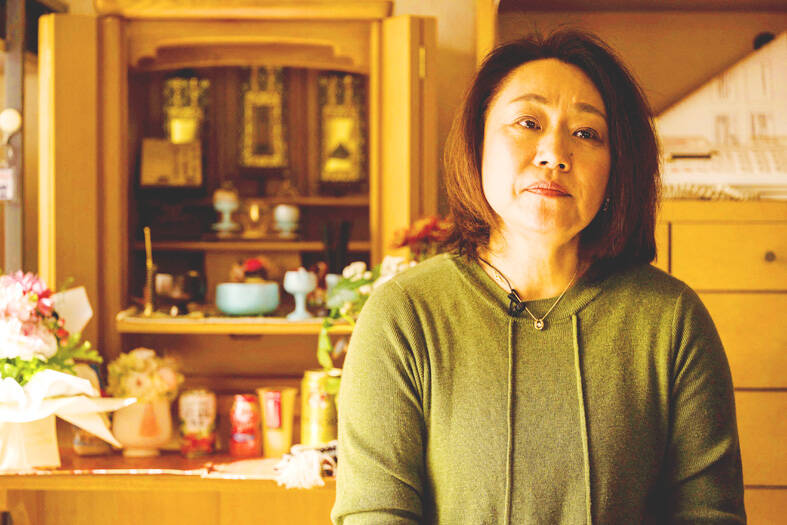In one of his last diary entries, Japanese teacher Yoshio Kudo lamented workdays that started early and could last until nearly midnight. Two months later, he suffered “karoshi” — death from overwork.
Kudo’s taxing schedule was far from an exception in Japan, where teachers work some of the longest hours in the world, saddled with tasks from cleaning and supervising school commutes to after-school clubs.
A 2018 Organisation for Economic Co-operation and Development survey found that Japanese middle-school teachers work 56 hours a week, versus an average 38 hours in most developed countries.

Photo: AFP
Yet that still fails to account for their astonishing amounts of overtime.
One investigation by a union-affiliated think tank found that school teachers work an average 123 hours of overtime each month, pushing their weekly workload well beyond the so-called “karoshi line” of 80 hours.
Teachers say they are reaching breaking point, and some have challenged the culture with lawsuits. This year, Japan’s ruling party established a task force to study the issue.

Photo: AFP
That came too late for Kudo, a middle-school teacher, who in 2007 died of a brain haemorrhage at the age of 40.
At his funeral, stunned students told his wife Sachiko that the lively physical education teacher was the “furthest imaginable person from death.”
“He just loved working with kids,” Sachiko, 55, said.
However, in his final weeks, he was struggling with his hours.
“Toward the end, he was telling me that teachers should stop working like this and that he wanted to lead that change in the future,” his widow said.
Japanese authorities have ordered steps including outsourcing and digitalizing some tasks.
“Our measures to reform work conditions for teachers are making steady progress,” Japanese Minister of Education, Culture, Sports, Science and Technology Keiko Nagaoka told the Japanese parliament in October.
However, she said that many “continue to work long hours” and “efforts need to be accelerated.”
Japanese Ministry of Education, Culture, Sports, Science and Technology data shows a gradual decline in overtime, but experts see little fundamental change.
From reams of paperwork to tasks like lunch distribution, leading daily cleaning sessions with students and monitoring children on their way to and from school, teachers in Japan “have in a way become handymen,” school management consultant Masatoshi Senoo said.
“What should really be the responsibility of parents sometimes spills over onto teachers, who can even be sent to apologize to local residents when students misbehave at parks or convenience stores,” he said.
One of the most all-consuming tasks is the supervision of student sports and cultural “club” activities, typically conducted after school and on weekends.
“Being assigned as primary supervisor of one of these clubs usually means you have to kiss your weekends goodbye,” said Takeshi Nishimoto, a high-school history teacher in Osaka.
In June, Nishimoto, 34, won a rare lawsuit seeking compensation for stress from overwork.
He filed the suit after coming close to a nervous breakdown in 2017, when the then-rugby club supervisor worked 144 hours of overtime in a single month.
Experts say teachers are particularly vulnerable to overwork because of a decades-old law that essentially prevents them from being paid for overtime.
Instead, the law adds eight hours’ worth of extra pay to their monthly salaries, a framework that Nishimoto says results in “making teachers work without limits for fixed pay.”
Masako Shimonomura, a middle-school physical education teacher in Tokyo’s Edogawa ward, said it can feel hard to take a proper break in her day.
“Not everything about this job is ‘black’ though,” she said, using a Japanese term for exploitative labor.
“There are some moments I live for, like watching students in my softball club shine and smile at tournaments,” said the 56-year-old, whose desk is covered with stacks of files and documents.
However, she said she fears that if conditions do not improve, “the image of our profession as ‘black’ will dominate for younger generations.”
An investigation by the Mainichi newspaper revealed that in the decade to 2016, there were 63 public school teacher deaths classified as caused by overwork.
However, it took Kudo’s widow five years to get her husband’s death recognized as karoshi, a task complicated by the lack of records for his work hours.
She said that teaching is often seen as a “sacred job” devoted to children, so anything viewed as selfish — including taking note of hours worked — can be frowned upon.
“So many teachers regret that they lived their lives without stopping to enjoy the growth of their own children,” she said.
A former schoolteacher herself, Sachiko now heads an anti-karoshi group in central Japan.
“I feel like my husband and I are working together to follow through on his last words — that he wants to change the working practices of teachers.”

Real estate agent and property developer JSL Construction & Development Co (愛山林) led the average compensation rankings among companies listed on the Taiwan Stock Exchange (TWSE) last year, while contract chipmaker Taiwan Semiconductor Manufacturing Co (TSMC, 台積電) finished 14th. JSL Construction paid its employees total average compensation of NT$4.78 million (US$159,701), down 13.5 percent from a year earlier, but still ahead of the most profitable listed tech giants, including TSMC, TWSE data showed. Last year, the average compensation (which includes salary, overtime, bonuses and allowances) paid by TSMC rose 21.6 percent to reach about NT$3.33 million, lifting its ranking by 10 notches

Popular vape brands such as Geek Bar might get more expensive in the US — if you can find them at all. Shipments of vapes from China to the US ground to a near halt last month from a year ago, official data showed, hit by US President Donald Trump’s tariffs and a crackdown on unauthorized e-cigarettes in the world’s biggest market for smoking alternatives. That includes Geek Bar, a brand of flavored vapes that is not authorized to sell in the US, but which had been widely available due to porous import controls. One retailer, who asked not to be named, because

SEASONAL WEAKNESS: The combined revenue of the top 10 foundries fell 5.4%, but rush orders and China’s subsidies partially offset slowing demand Taiwan Semiconductor Manufacturing Co (TSMC, 台積電) further solidified its dominance in the global wafer foundry business in the first quarter of this year, remaining far ahead of its closest rival, Samsung Electronics Co, TrendForce Corp (集邦科技) said yesterday. TSMC posted US$25.52 billion in sales in the January-to-March period, down 5 percent from the previous quarter, but its market share rose from 67.1 percent the previous quarter to 67.6 percent, TrendForce said in a report. While smartphone-related wafer shipments declined in the first quarter due to seasonal factors, solid demand for artificial intelligence (AI) and high-performance computing (HPC) devices and urgent TV-related orders

MINERAL DIPLOMACY: The Chinese commerce ministry said it approved applications for the export of rare earths in a move that could help ease US-China trade tensions Chinese Vice Premier He Lifeng (何立峰) is today to meet a US delegation for talks in the UK, Beijing announced on Saturday amid a fragile truce in the trade dispute between the two powers. He is to visit the UK from yesterday to Friday at the invitation of the British government, the Chinese Ministry of Foreign Affairs said in a statement. He and US representatives are to cochair the first meeting of the US-China economic and trade consultation mechanism, it said. US President Donald Trump on Friday announced that a new round of trade talks with China would start in London beginning today,